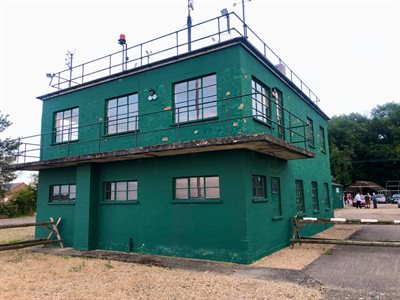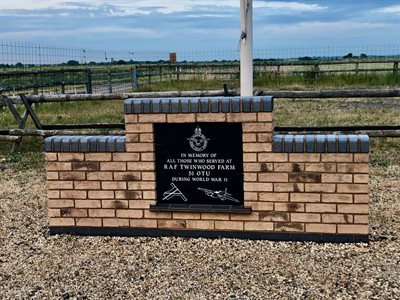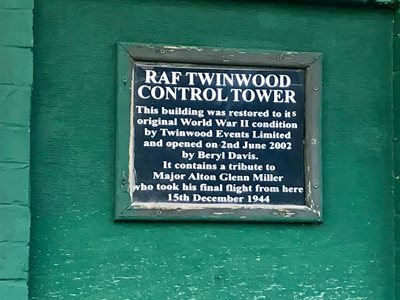Twinwood Farm and Air Base Clapham
![North elevation of Twinwoods Farmhouse in 1939 [RDBP3-121]](/CommunityHistories/Clapham/Clapham-Images/North-elevation-of-Twinwoods-Farmhouse-in-1939-RDBP3-121.jpg)
North elevation of Twinwood Farmhouse in 1939 [ref: RDBP3/121]
Twinwood Farm formed part of the Oakley Estate belonging to the Duke of Bedford, which was put up for sale by auction in October 1918. Twin Wood Farm, as it is there called, was Lot 33 and was described as a sheep and corn-growing farm extending to 240 acres, 1 rood, 10 poles. The house was listed as comprising a parlour, a kitchen, a dairy and cellar, four bedrooms, as washhouse and a coal barn. Water came from a tank. The homestead was recorded as enclosing two yards and comprising: a chicken house; a calf pen; cow stalls for two; a mixing room; a barn; a pig house; a meal room; three loose boxes; a cart horse stable for six; a chaff house and a three-bay implement shed with a granary over. The tenant was J J Laughton. The lot was withdrawn.
The Rating and Valuation Act 1925 specified that every building and piece of land in the country was to be assessed to determine its rateable value. The valuer visiting Twinwoods Farm [ref: DV1/H8/30] found it owned by W and H Quenby and occupied by R Quenby. He commented: “was farmed with others”
In 1923 the rent was fixed at £1 per acre and the farm included three homesteads, a house and two cottages. The extent of the farm had been 408 acres pre-war, but was now 450 acres. The combined acreage of Twin Wood Farm, Little Wood Farm, and Brown’s Wood Farm in the 1918 sale catalogue comes to 480 acres so the figure of 408 may be an error. The valuer commented: “One mile of private road to keep up … No water laid on, pay rate but farm too high”. The farm had land in Clapham, Oakley and Milton Ernest.
The valuer’s visit took place on 11 April 1927 and he noted: “House fair only. Good set main buildings 2 others labourers and 2 other houses (now as cottages). Was 3 farms. Grass scarce and poor. Onions in masses especially in Oakley. Position bad rent high. Keeps his hedges very well” The farmhouse comprised one reception room, a kitchen, cellar and dairy with a scullery outside with a coal shed. There were four bedrooms upstairs. Water came from a pump in the scullery. The valuer noted: “Garage?”
The brick and slate homestead comprised a cow house for seven and a mixing room, a brick and slate six-bay open hovel and a brick and slate cake store, barn and two loose boxes. Other farm buildings were in two groups. At Twinwoods Farm were: a brick and slate east block comprising a loose box, a three-bay open hovel, two loose boxes and a separate single loose box. A north block had a cow shed for six beasts and a barn. Next to the yard were three loose boxes, two big calf-pens, a three-bay hovel and a stable for six horses as well as a feed place, a wood and thatched five-bay hovel, a shed and a three-bay cart shed with a granary over. At Little Wood Farm was a tool shed, a two-bay open hovel and loose box, a barn, two more loose boxes, two pigsties and a two-bay open cart shed - all described as “poor”.

Twinwood Control Tower (July 2019)
In the early days of World War Two 330 acres of the farm was commandeered by the Air Ministry for use as an airfield to protect Bedford. From Spring 1942 the airfield was used for training pilots and as a night-fighter base using twin-engined Bristol Beaufighters. From July 1944 the Band of the Allied Expeditionary Forces used Twinwoods for getting to and from Bedford, where it was based. This band was led by the famous bandleader Glenn Miller. It was from Twinwood that he took-off on 15th December 1944 never to return, his disappearance being a mystery to this day. When the war in Europe ended the airfield was closed.

Twinwood Memorial (July 2019)
In 1983 the Ministry of Defence put Twinwood Farm up for sale. At that time the farm comprised 633 acres. The farmhouse comprised: a drawing room measuring 15 feet by 12 feet 9 inches, a dining room measuring 14 feet 8 inches by 12 feet 10 inches, a kitchen, a cloakroom with WC and lavatory basin. Two of the three bedrooms each measured 14 feet 9 inches by 12 feet 6 inches, the other measured 12 feet 3 inches by 9 feet 7 inches. There was also a bathroom upstairs.
The farm also contained a house and a bungalow as well as farm buildings. Some buildings were left over from the RAF days such as a corrugated iron hanger adjoining Little Oakley Wood and measuring 89 feet by 45 feet, a messroom and Nissen huts used as stores and measuring 91 feet 6 inches by 28 feet 6 inches. The farm had been leased to A T Quenby since 1962.

Plaque on Twinwoods Control Tower (July 2019)
In 1989 work started to restore the Twinwood Control Tower and convert it into a Glenn Miller Museum. The first Glenn Miller Festival was held at Twinwood in 2002, and in 2007 the name was changed to Twinwood Festival. This is held annually and has developed into one of the largest vintage music festivals in the Europe.